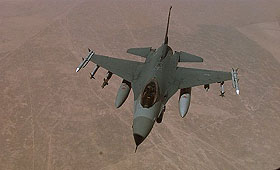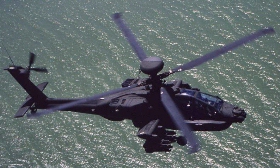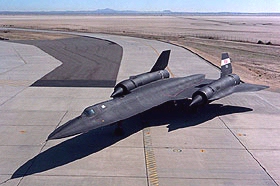| |

In war there is no substitute for victory. --Douglas MacArthur
 elcome to my page focusing on advanced airborne killing machines and modern warships (mostly American 'cause nobody makes 'em as well as we do).
I've also thrown in a few aerospace and space exploration links here. Anyway, this fascination with military aircraft, firepower, hardware, technology, and weaponry is not necessarily indicative of my political orientation. (I have to tread carefully here; after all, we are in Berkeley.) I just happen to like the technology of fast planes, big guns, and even bigger ships. How they are used is another matter. Anyway, civil aviation links can be found in my travel and transportation page. For our convenience, this fairly straightforward links page is divided into: elcome to my page focusing on advanced airborne killing machines and modern warships (mostly American 'cause nobody makes 'em as well as we do).
I've also thrown in a few aerospace and space exploration links here. Anyway, this fascination with military aircraft, firepower, hardware, technology, and weaponry is not necessarily indicative of my political orientation. (I have to tread carefully here; after all, we are in Berkeley.) I just happen to like the technology of fast planes, big guns, and even bigger ships. How they are used is another matter. Anyway, civil aviation links can be found in my travel and transportation page. For our convenience, this fairly straightforward links page is divided into:


- Eurofighter Typhoon is a highly manoeuvrable, versatile, multi-role, combat fighter developed for Germany, Italy, Spain, and the U.K. with both air-to-air as well as air-to-surface capabilities.
- F-4 Phantom II was McDonnell Douglas's very popular Cold War-era interceptor and air-to-ground striker.
- F-14 Tomcat is "a supersonic, twin-engine, variable sweep wing, two-place fighter designed to attack and destroy enemy aircraft at night and in all weather conditions."
- F-15 Eagle is the old reliable for air to air combat missions.
- F-16 Falcon. If you gush over this highly-manoeuvrable high-tech Fighting Falcon like I do, this one's for you.
- F/A-18 Hornet Strike Fighter, the only American aircraft with dual-mission-capable designations (air-to-air as well as air-to-ground).
Be sure also to check out Hornet Hyperlink, the official site of the F/A-18 Strike Fighter Program.
- F-20 Tigershark. Intended by Northrop in the early 1980s to be a multi-role, tactical fighter, it had a rather beautiful form, but in the end, it was an enormous technical and financial fiasco.
- F-22 Raptor is the relatively new fighter (intended to replace the Eagle) with almost air-to-ground capabilities. Here's another cool Raptor page.
- F-111 Aardvark was another cold war relic that had too many problems, but it had an interesting history though.
- F-117A Nighthawk stealth fighter is another plane to gush over. Find out more here.
- MiG-21 Page is exactly what it is.
- MiG-29 was the Soviets' formidable answer to the F-16.


- B-1 Lancer is a very fast, very long-range, multi-role, heavy bomber (intended to replace the B-52) whose aesthetic design is just breathtaking. It appears at the top of this page.
- B-2 Spirit stealth bomber is very well-presented here.
- B-17 Flying Fortress. Classic bomber used in the European theatre of WWII.
- B-24 Liberator. Classic bomber used just about everywhere in WWII.
- B-29 Superfortress, the aircraft used in the Pacific theatre of WWII and the incineration of Japanese cities.
The Errol Morris documentary Fog of War reiterated something that has always disturbed me, as a historian and as an individual who feels that we should never forget or disregard the incomprehensible ravages of war on civilians.
Conventional firebombing of Japanese cities in World War II has largely been forgotten, just like the relentless conventional bombing of German cities that began earlier in the war.
(The latter was recounted hauntingly by the late German writer W.G. Sebald in On the Natural History of Destruction, which challenged the lack of acknowledgement of the fact that the brutal air war on 131 German cities killed some six hundred thousand civilians and destroyed the homes of more than seven and a half million people.
Incidentally, the city of Dresden was memorialised quite memorably in Slaughterhouse-Five.)
About this documentary, Roger Angell wrote in the January 19, 2004 issue of the New Yorker:
…[Robert] McNamara’s testimony cuts deepest when he goes back to the Second World War firebombing of Tokyo by the American Twentieth Air Force, whose high-altitude B-29 bombers,
redeployed at five thousand feet, rained down incendiaries that killed at least eighty-five thousand civilians in a single night. This campaign was continued almost in secrecy against lesser targets,
and here, to a thrumming score by Philip Glass, Morris transforms clustering names of the burnt-down wooden Japanese cities into equivalent American towns, with the percent of residents killed attached:
thirty-five percent of Chicago, fifty-eight percent of Cleveland, ninety-nine percent of Chattanooga, forty-two percent of Toledo, and so on.
Sixty-seven Japanese cities were firebombed by the B-29s in the spring of 1945, and three hundred and fifty thousand civilians burnt to death- and the war in effect won- well before Hiroshima.
B-52 Stratofortress. Also be sure to check out a cool pictorial article about the old reliable workhorse from Boeing.


- AH-64 Apache helicopter of the U.S Army is an astonishing work of engineering.
It was originally developed and built by McDonnell Douglas to be the Army's principal gunship / antitank helicopter.
- CH-46 Sea Knight was built by Boeing as a workhorse that has served as a medium assualt helicopter for the U.S.M.C. since Vietnam and through the Gulf War.
In the U.S. Navy, it serves as a main vertical on-board delivery aircraft.
- CH-47 Chinook is similar to the CH-46 Sea Knight. It was developed by Boeing for the U.S.Army.
With a larger fuselage (carrying 3 crew and up to 44 troops) and less landing gear options, the Chinook is mainly a medium transport helicopter.
- CH-53 Sea Stallion is a heavy lift helicopter built by Sikorsky, and widely used by the U.S. Navy and Marines for assault, vertical replenishment, and mine countermeasures operations.
The E-series, also known as Super Stallions, are the heaviest helicopters used by the American military, and they can carry up to 3 crew and 55 troops.
- SH-60 Sea Hawk by Sikorsky is a flexible helicopter developed for antisubmarine warfare and search and rescue operations.
It is adapted from the U.S. Army's UH-60 Black Hawk.
- UH-60 Black Hawk by Sikorsky serves as the primary tactical transport helicopter, capable of doing everything from medical evacuation, reconnaissance, search and rescue operations, to electronic warfare and intelligence missions.
Here's the entry from Jane's.


- A-10 Thunderbolt II. Loads of stuff on the old Warthog.
- AV-8B Harrier II is an amazing engineering wonder popularised by its service in the Marines. Its V/STOL (Vertical/ Short Take-Off and Landing) feature uses 21,000 pounds of vectored thrust to lift itself straight up.
- C-5 Galaxy, built by Lockheed, has a pretty patchy record, but it is astonishingly enormous. According to the Air Force Fact Sheet, "The Galaxy carries nearly all of the Army's combat equipment, including such heavy oversized items such as its 74-ton mobile scissors bridge, from the United States to any theater of combat on the globe... The C-5, C-17 Globemaster III and C-141 Starlifter are partners of AMC's strategic airlift concept. The aircraft carry fully equipped, combat-ready military units to any point in the world on short notice then provide field support required to help sustain the fighting force."
- C-17 Globemaster III is "the newest, most flexible cargo aircraft to enter the airlift force."
- C-141B Starlifter is Lockheed's longtime workhorse of the Air Force cargo aircraft fleet, used also for medical evacuation, paratroop drops, and troop transport.
- SR-71 Blackbird at Dryden Flight Research Center. As a matter of fact, the Dryden site also features a substantial image collection of all sorts of planes in addition to those depicting the illustrious strategic reconnaissance aircraft.
- SR-71 Blackbird at Habu.org is "the Online Blackbird Museum," another fine SR-71 site.
- SR-71 Blackbird. Past, present & future.
- VC-25A (Air Force One) is the most expensive transport plane in existence.




- AEGIS combat system.
- Air & Space. Smithsonian's aviation magazine.
- Air Force Flight Test Center at Edwards Air Force Base.
- Air Force Space Command site features stuff about global positioning systems and rockets.
- U.S. Navy Blue Angels.
- Boeing.
Despite the dominance of Airbus, and despite continued presence of centre seats on economy class cabins (and let's not even go into the sadistic 5-seats in a row of some American carriers),
and the continued management problems since merger with McDonnell Douglas notwithstanding, you can't help but feel a sense of awe for its illustrious history and its product line past and present.
Strangely enough, going out one day to the Boeing assembly plant in Everett and seeing Old Glory hanging inside the world's largest building (in terms of volume) triggered one of the rare instances of unabashed patriotism within me.
Seeing the impressive row upon row of 747s, 767s, and 777 widebodies being manufactured in that great big building certainly drives the point home.
The only thing more impressive than the engineering was the staggering logistics of putting together a plane such as the 747-400, which has more than six million components.
God bless America!
- Bombardier Aerospace of Canada.
- Canadian Air Force equipment, the official version.
- Dassault Aviation is responsible for the French Mirage fighters.
- DefenseLINK, official website of the Defense Department.
- FlightDeck covers Canadian aviation.
- Frontline: Ambush in Mogadishu is a very well-designed site with extremely detailed information and specs on the hardware used in the disastrous 1993 Somali operations. Find out all about what the hell a RPG is.
- Frontline: The Gulf War has everything about the war and all its awesome firepower and technology. That conflict represented the ultimate bechmark for the new generation of military technology and weaponry.
- General Dynamics.
- General Dynamics Land Systems are responsible for the Abrams tanks, among other things.
- The High Energy Weapons Archive. Thanks, Mike.
- Jane's. The one and only. 411 on everything.
- Jet Propulsion Laboratory. They don't make bombs, but you get the most
bang for your (taxpayer) buck with this agency.
Their projects and missions constitute perhaps the most fascinating endeavour that human beings have ever been engaged in:
the exploration of space. The images that their probes have brought back are some of the most breathtaking and thought-provoking that I've ever come across.
Their accomplishments are simply astonishing, and Americans should be very proud of them.
A recent example of their many achievments in space exploration is the Cassini mission to Saturn.
- Lockheed Martin.
- Loral Space & Communications.
- Die Luftwaffe has an elegantly-designed official website. Auf Deutsch.
- Military history guide is extremely useful and handy.
- Missile Index has the 411 on all the world's missile systems.
- NASA homepage.
- NASA Shuttle Web has everything about the space shuttle. Incidentally, haven't you noticed that Americans, rather out of character, give really cool names to the space shuttles? Even though Americans can never be synonymous with good taste, we nonetheless came up with really elegant names for our distinguished fleet: Columbia, Challenger, Discovery, Atlantis, and Endeavour.
- National Air and Space Museum.
- Naval Air Warfare.
- Naval Air Warfare Center Aircraft Division.
- Northrop Grumman.
- Patriot Missile Home Page has everything you would want to know about these long range, all altitude, all weather buggers.
- Raytheon Systems Company makes lots of missiles.
- Ryan Kirk's Ultimate Skunk Works Site.
- Sikorsky of United Technologies makes choppers.
- Trotsky's Weapons Platform is a good resource providing info. and pics on naval ships throughout the world.
- U.S. Air Force's main site has an incredible photographic collection. You can stay here forever.
- U.S. Air Force Air Combat Command has loads of stuff to see and do.
- U.S. Air Force Museum contains extensive pics on the history of American air power.
- U.S. Army.
- U.S. Marine Corps.
- U.S. Navy.
- United Technologies Corporation.
- Vulture's Row is "an online U.S. Naval aviation resource" site.


- Amphibious Assault Ships (LHA, LHD: Wasp class, Tarawa class) are far from being pretty, but these big monsters perform the vital task of landing troops in hostile territory. The largest can hold up to almost 3000 men (including Marine detachment of about 1900 men).
- USS Kitty Hawk (CV-63), stationed in Yokosuka Japan, replaces the old USS Independence (CV-62) as the only permanently forward-deployed carrier in the U.S. Navy.
- Litton Ingalls Shipbuilding provides detailed information on many of its contributions to the Navy.
- USS Missouri (BB-63) was the last active battleship in the Navy. It was also the place where General MacArthur accepted the formal surrender of the Japanese, ending WWII. This is the official site of the illustrious ship, now docked in Pearl Harbor.
- Newport News Shipbuilding is responsible for the awesome Nimitz class nuclear-powered carriers. This site features detailed stuff about carrier and submarine technologies.
- Nimitz Class Aircraft Carriers are the largest warships in existence. Powered by nuclear reactors (designated with an additional 'N' before the hull number), the newest currently operational carrier of these eight ships is the USS Harry S. Truman (CVN-75).
- U.S. Navy Fact File is a very useful and easy to use guide if you need the 411 (esp. on weaponry and ships) fast.
- U.S. Navy aircraft carriers page (CV, CVN: Nimitz class, Enterprise, John F. Kennedy, Kitty Hawk class, Forrestal class) provides relatively detailed history, information, specs, and pics on the nation's awesome carrier fleet.
- U.S Navy cruisers (CG, CGN: Ticonderoga class).
- U.S. Navy destroyers (DD, DDG: Aleigh Burke class, Kidd class, Spruance class) are fast warships that help safeguard larger ships in a fleet or battle group.
- U.S. Navy frigates (FFG: Oliver Hazard Perry class).
- U.S. Seventh Fleet controls the Pacific and Indian Oceans.


Reach us at 'bcbloke' on all the usual social media platforms
|












 elcome to my page focusing on advanced airborne killing machines and modern warships (mostly American 'cause nobody makes 'em as well as we do).
I've also thrown in a few aerospace and space exploration links here. Anyway, this fascination with military aircraft, firepower, hardware, technology, and weaponry is not necessarily indicative of
elcome to my page focusing on advanced airborne killing machines and modern warships (mostly American 'cause nobody makes 'em as well as we do).
I've also thrown in a few aerospace and space exploration links here. Anyway, this fascination with military aircraft, firepower, hardware, technology, and weaponry is not necessarily indicative of 





